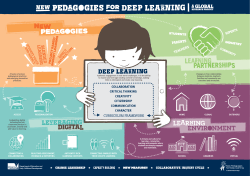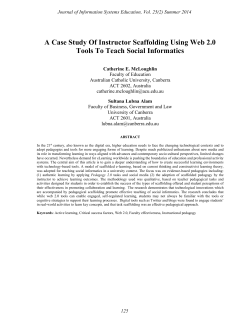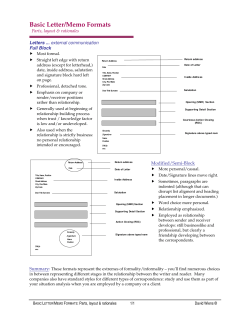
UNIVERSITY TEACHING AND LEARNING
EDITED BY Lotte Rienecker Peter Stray Jørgensen Jens Dolin Gitte Holten Ingerslev UNIVERSITY TEACHING AND LEARNING University Teaching and Learning KAPITEL 7.5. Underviserrollen University Teaching and Learning Edited by Lotte Rienecker, Peter Stray Jørgensen, Jens Dolin and Gitte Holten Ingerslev Samfundslitteratur Lotte Rienecker, Peter Stray Jørgensen, Jens Dolin and Gitte Holten Ingerslev (eds.) University Teaching and Learning 1. edition 2015 © Samfundslitteratur 2015 Original edition in Danish with the title Universitetspædagogik published by Samfundslitteratur 2013. The translation of this work was made possible by a grant from Lundbeck Foundation Translation: Elisabeth Li Translation revised by: Nicolai Paulsen Cover: Imperiet Cover illustration: Gitte Holten Ingerslev Typeset: SL grafik (slgrafik.dk) Print: Specialtrykkeriet Viborg A/S ISBN: 978-87-593-1960-4 E-book ISBN: 978-87-593-2252-9 Resources at: samfundslitteratur.dk/utl Samfundslitteratur Rosenørns Allé 9 DK-1970 Frederiksberg C slforlagene@samfundslitteratur.dk samfundslitteratur.dk All rights reserved. No part of this publication may be reproduced or used in any form or by any means – graphic, electronic or mechanical including photocopying, recording, taping or information storage or retrieval systems – without permission in writing from Samfundslitteratur. Table of Contents Foreword to the English edition · 15 1.1 Trends in the development of the Danish universities · 17 FREDERIK VOETMANN CHRISTIANSEN, THOMAS HARBOE, SEBASTIAN HORST, LONE KROGH AND LAURA LOUISE SARAUW Humboldt and the research-based university · 17 From elite university to mass university · 20 New governance structures and management styles · 23 Learning outcome and competence-oriented university education · 33 Concluding remarks · 37 Resources · 38 Literature · 40 1.2 Research-based teaching · 43 NINA BONDERUP DOHN AND JENS DOLIN Research-teaching nexus · 44 Different approaches to research-based teaching · 47 Different disciplines’ different approaches to research-based teaching · 51 Examples of research-based teaching · 54 Literature · 62 2.1 Teaching for learning · 65 JENS DOLIN Explicit, implicit and behaviourist learning · 65 Three approaches to teaching · 68 Constructivism · 70 Situated learning, apprenticeship, practice communities · 78 Psychodynamic learning approaches · 82 Progression · 83 Is there a “best practice”? (Or: Can you base teaching on evidence?) · 85 Ideas and practice · 87 Literature · 91 2.2 University teaching and learning – models and concepts · 93 ANNE METTE MØRCKE AND CAMILLA ØSTERBERG RUMP Instructions and options · 93 Models and principles of university teaching and learning · 94 Taxonomies · 100 Resources · 103 Literature · 104 2.3 Teaching environment · 105 SEBASTIAN HORST AND GITTE HOLTEN INGERSLEV What can the teacher do to create a good teaching environment? · 106 Research-based starting points for planning teaching · 110 Research-based education requires integration with research facilities · 111 Resources · 112 Literature · 113 3.1 Who are the students? · 115 BJØRN FRIIS JOHANNSEN, LARS ULRIKSEN AND HENRIETTE TOLSTRUP HOLMEGAARD Challenges to teaching: Who are the students? · 118 Options · 124 Conclusion · 132 Resources · 132 Literature · 133 3.2 Course descriptions · 135 FREDERIK VOETMANN CHRISTIANSEN, SEBASTIAN HORST AND CAMILLA ØSTERBERG RUMP Course descriptions are part of the regulations · 135 What should a course description include? · 136 Goal descriptions and the Danish Qualifications Framework · 137 How do competences, skills and knowledge differ from one another? · 139 Conclusion · 146 Resources · 147 Literature · 147 3.3 Session planning · 149 PETER STRAY JØRGENSEN The teacher’s challenges · 149 The teacher’s planning · 150 Handouts as learning tools · 159 Reasons · 161 Resources · 162 Literature · 162 3.4 Course planning · 165 PETER STRAY JØRGENSEN Challenges · 165 The course planner’s options · 167 A course’s content · 167 The course’s framework · 169 Rationales · 172 Resources · 173 Literature · 174 3.5 Instructing written assignments · 175 PETER STRAY JØRGENSEN Instructions, options · 175 Rationales · 177 Resources · 177 Literature · 177 4.1 Lecturing · 179 BETTINA DAHL AND RIE TROELSEN Introduction · 179 Pedagogical challenges · 179 Considerations before a lecture · 181 Activities while you lecture · 184 Rationales · 186 The lecturer as a performer · 187 Resources · 188 Literature · 188 4.2 Group work · 189 GERD CHRISTENSEN Definition and history · 189 Pedagogical challenges in connection with group work · 190 Different forms of group work · 191 Suggestions for practice/action · 192 Structure of the collaboration · 195 Rationales and substantiation from research · 197 Resources · 198 Literature · 199 4.3 Case-based learning · 201 LONE KROGH, DIANA STENTOFT, JEPPE EMMERSEN AND PETER MUSAEUS The case method and its background · 201 Challenges when working with cases · 204 Pedagogical possibilities · 207 Rationales and theoretical foundation for the use of cases in teaching and learning · 211 Resources · 213 Literature · 214 4.4 Problem-based and project-organised teaching · 215 LONE KROGH AND MERETE WIBERG Introduction · 215 Central elements in problem-based project work · 217 Group work, project organisation and student direction? · 218 Problem-based learning, connecting theory and practice, interdisciplinarity · 220 The principle of exemplarity · 223 Rationales – theoretical foundation for problem-based project work · 225 Literature · 226 4.5.1 Activities in and between teaching sessions · 229 LOTTE RIENECKER, RIKKE VON MÜLLEN, PETER STRAY JØRGENSEN AND GITTE HOLTEN INGERSLEV Pedagogical challenges · 230 Activities in teaching · 231 Activities between sessions · 239 Choice and planning of activities · 240 Rationales · 245 Resources · 248 Literature · 248 4.5.2 Disciplinary activities · 251 LOTTE RIENECKER, RIKKE VON MÜLLEN, JENS DOLIN, PETER MUSAEUS AND ANNE METTE MØRCKE Teaching activities in the Humanities · 251 Teaching activities in the Social Sciences · 253 Teaching activities in the Natural Sciences · 254 Teaching activities in the Medical Sciences · 255 Literature · 257 4.6.1 Feedback · 259 LOTTE RIENECKER AND JESPER BRUUN What is feedback? · 259 Pedagogical challenges · 260 Pedagogical recommendations · 263 Feedback on written and oral student performances · 264 Automated feedback in an online environment – quizzes and academic games · 269 Experiment with feedback · 272 Peer-feedback research · 275 Online feedback research · 277 Resources · 278 Literature · 279 4.6.2 Clickers · 281 HELLE MATHIASEN What is a clicker? · 281 Clickers in teaching · 282 Studies of clickers in teaching · 285 Resources · 286 Literature · 287 4.7 Discussions and argumentation in teaching · 289 MADS THORKILD HAUGSTED AND GITTE HOLTEN INGERSLEV Intro · 289 Challenges · 289 Instructions/options · 289 Rationales · 295 Resources · 296 Literature · 296 4.8 E-learning · 299 NINA BONDERUP DOHN, MARIANNE THORSEN AND SØREN LARSEN Intro: What is e-learning? · 299 Pedagogical challenges · 300 Options · 302 Example: Qualification of preparation for practical exercises through online learning resources · 304 Some advice and suggestions · 308 Example: Creating coherence between students’ learning contexts through the use of blogs and wikis · 310 Some advice and suggestions · 315 Example: Learning through social construction of knowledge. Use of discussion forums in fully online teaching · 317 Some advice and suggestions · 323 Research-based evidence · 324 Resources · 325 Literature · 326 5.1 Supervision: Process management and communication · 327 GITTE WICHMANN-HANSEN AND TINE WIRENFELDT JENSEN Common challenges for supervision · 327 Which strategies for action do supervisors have? · 328 The importance of good cooperative relationships and negotiation of expectations · 329 Teaching model, apprenticeship model or partnership model? · 334 The partnership model – why and how? · 335 Meta-communication · 336 Framing the student’s responsibility · 337 Dialogue-based supervision · 338 The conversation model used in supervision – a case · 341 The personal dimension and the difficult conversation · 346 Creating a learning space in supervision · 347 Resources · 348 Literature · 348 5.2 Text in supervision – supervising on texts · 351 PETER STRAY JØRGENSEN AND LOTTE RIENECKER The supervisor’s challenges · 351 The supervisor’s options · 354 Rationales · 365 Resources · 366 Literature · 367 6.1 Assessment and exams · 369 HANNE LETH ANDERSEN, BETTINA DAHL AND JENS TOFTESKOV Examining and assessing: Focus on the students’ performance · 370 TYPES OF EXAMS · 371 Challenge: Insight into chosen types of exams · 371 Oral exams · 373 Suggestions · 374 Written on-campus exam · 380 Suggestions · 381 Written take-home exams · 385 Suggestions · 385 ASSESSMENT AND MARKING · 393 Qualification frameworks and level descriptions · 398 EXAM CONDITIONS AND CRITERIA · 400 Cheating and plagiarism · 400 Options · 401 Validity and reliability: Criteria for choosing exam types · 403 Resources · 406 Literature · 407 6.2 Teaching evaluation · 409 SEBASTIAN HORST, BJØRN FRIIS JOHANNSEN, JAN ALEXIS NIELSEN AND CAMILLA ØSTERBERG RUMP Pedagogical challenges · 409 Options · 412 Rationales · 420 Conclusion · 420 Resources · 421 Literature · 421 7.1 Developing your own teaching · 423 JAN SØLBERG The reflective teacher · 423 Which factors are interesting for developing your teaching? · 423 How can you develop your own teaching? · 426 Development as research into teaching · 429 Resources · 430 Literature · 431 7.2 Collegial supervision · 433 HANNE LETH ANDERSEN AND LENE TORTZEN BAGER Introduction: Pedagogical development of own and shared premises? · 433 Instructions: Frameworks, roles, inquisitive approach · 434 Rationales and evidence · 439 Evaluation and outcome · 443 Resources · 443 Literature · 444 7.3 Teaching portfolios · 445 BETTINA DAHL AND LONE KROGH The definition of a teaching portfolio · 445 Pedagogical challenges of the teaching portfolio · 446 Instructions for making a teaching portfolio · 449 Rationales for a teaching portfolio · 451 Resources · 453 Literature · 454 7.4 Information search about university teaching and learning · 455 LOTTE RIENECKER Challenge: Bringing new and relevant research on university teaching and learning into play · 455 Instructions and options · 456 Rationales · 462 Resources · 464 7.5 The role of the university teacher · 465 RIE TROELSEN AND JENS TOFTESKOV Do what you can – not what your course leader tells you to… · 466 The role of the professional university teacher · 470 The reflecting teacher · 473 Teaching is both a fun and risky business · 477 Resources · 478 Literature · 479 Author Profiles · 481 Index · 489 Foreword to the English edition University Teaching and Learning is the first comprehensive Danish textbook about university teaching. This textbook is intended for teaching and learning in higher education programmes and other introductory courses for university teaching and learning. The book is for both new teachers and teachers looking for inspiration for their own, their team’s, or their institution’s teaching. This translation of the Danish edition meets an expressed need from those teaching university pedagogy to International faculty teaching in Denmark. The questions of what constitutes good university teaching, which principles are involved, which models are used are under constant debate. In this book, the quality of teaching is not a question of quantity, of how many students complete the programme, of how quickly they do so and with how many contact hours, but rather a matter of content, form and learning for both students and teachers. The fundamental idea is that good university teaching is learning- and student-oriented. Learning activities in teaching and between sessions therefore play an important role in this book. The book is intended to assist teachers in their work, and therefore contains many specific suggestions for practice. The book’s 32 authors are practitioners, developers and researchers, most of them are educational developers at the different universities and research centres in Denmark. Most Danish universities and faculties are represented here, and many of the book’s chapters are written in collaboration by authors from different faculties. The book is not heavy on theory, but is theory- and research-based. We have aimed for an identical structure in all the book’s sections: Each chapter opens with a presentation of the pedagogical themes and the teacher’s challenges, followed by a presentation of various options for the teacher. To argue for and substantiate these options, we also present the rationales behind our suggestions. Finally we recommend resources and literature for further reading. The Danish edition, Universitetspædagogik, has been translated into University Teaching and Learning by Elizabeth Li and revised by Nicolai Paulsen. 15
© Copyright 2025













